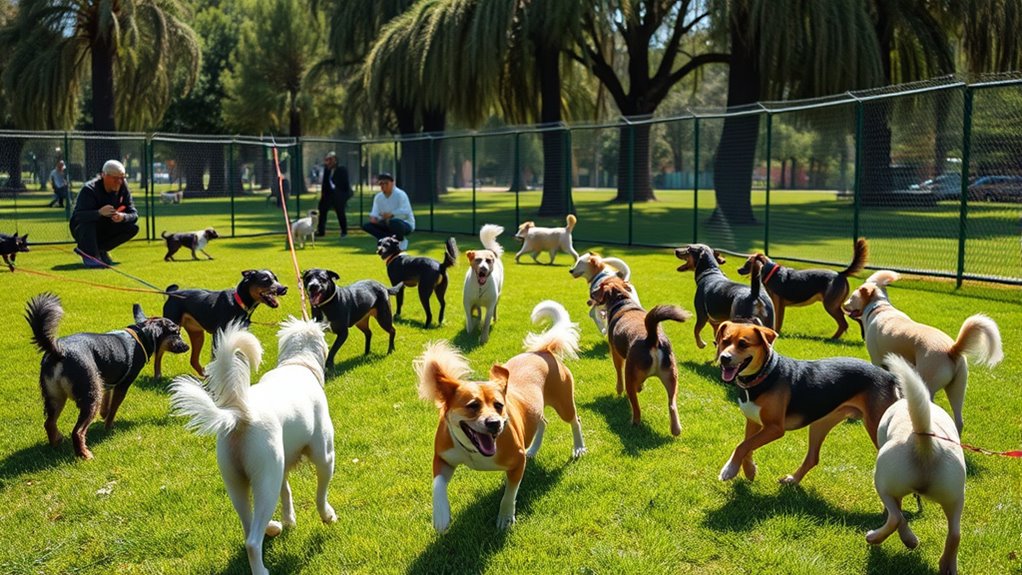To guarantee safety and fun at the dog park, always obey leash rules and respect posted signage. Keep your dog under control, especially during first visits or training, and avoid breed restrictions by checking local policies beforehand. Be attentive to your dog’s behavior and watch for signs of aggression or anxiety. Responsible owners foster a friendly environment where everyone can enjoy their time. Sticking to these guidelines helps create a safe space—if you want more tips, keep exploring.
Key Takeaways
- Keep dogs on a leash when entering and exiting the park, and follow designated off-leash zones’ rules.
- Monitor your dog’s behavior; address signs of aggression or anxiety immediately.
- Respect breed restrictions and park-specific policies to ensure safety for all dogs and owners.
- Clean up after your dog and dispose of waste properly to maintain a clean environment.
- Supervise your dog at all times, and avoid bringing multiple dogs if you’re not experienced in managing them.

Have you ever wondered why dog parks have become such popular spots for pet owners? It’s because they offer a space where your dog can socialize, run freely, and burn off energy. But to make these visits enjoyable and safe for everyone, understanding the rules is vital. Leash regulations are a big part of that. Most dog parks require dogs to be on a leash when entering and exiting the park area. Once inside, many parks have designated off-leash zones, but it’s essential to pay attention to signage. Some parks enforce strict leash policies at all times, especially if they’re in areas with high foot traffic or near roads. You should always keep your dog under control, even in off-leash sections, especially if it’s your pup’s first visit or if they’re still learning good manners. Ignoring leash regulations can lead to accidents, fights, or even injuries, which no owner wants to deal with. Besides leash rules, breed restrictions are also common at many dog parks. Some parks restrict access to certain breeds, like aggressive or large breeds, to prevent incidents. These restrictions are usually based on local regulations or park policies designed to keep everyone safe. If your dog belongs to a breed that’s restricted, you might need special permission or may need to visit alternative parks. It’s your responsibility to check the park’s rules before visiting, so you don’t find yourself turned away at the entrance. When planning a trip to the park, take a moment to review the rules posted at the entrance or on the park’s website. Respect the leash regulations, even if your dog is well-behaved, because they’re there for everyone’s safety. If your dog shows signs of aggression or anxiety, consider consulting a trainer before visiting crowded parks. Breed restrictions aren’t meant to discriminate but to prevent potential issues that could ruin the experience for others. Following these rules also shows respect for fellow pet owners and helps maintain a positive environment. Remember that your behavior influences others—if you’re attentive to leash rules and breed restrictions, you’re contributing to a safer, more enjoyable space. Additionally, many parks have support hours or staff available during certain times to assist visitors if needed. Understanding and adhering to leash regulations and breed restrictions helps guarantee that everyone, including your dog, has a good time. It’s about being responsible, considerate, and proactive. This way, you can enjoy all the benefits that dog parks offer, from socialization to exercise, without risking safety or creating conflicts. When everyone follows the rules, dog parks stay fun, friendly, and safe places for all four-legged and two-legged visitors alike.
Frequently Asked Questions
Can I Bring Food or Treats Into the Dog Park?
You can bring dog treats into the park, but avoid bringing human food, as it can pose food safety risks for dogs. Make sure your treats are safe, easy to carry, and won’t cause allergies or reactions. Always supervise your dog when giving treats, and be mindful of other dogs’ reactions. Keep treats in a secure container to prevent accidental sharing, and remember, safety and good manners are key at the park.
Are There Age Restrictions for Dogs Entering the Park?
Surprisingly, most dog parks have age restrictions for dogs, even though you’d think that puppies can socialize just as well as adults. Check the park’s age policies before you visit — typically, dogs must be at least four to six months old to enter. This guarantees safety for all. Ignoring these dog age restrictions can lead to fines or being asked to leave, so play it safe and follow the rules.
What Should I Do if My Dog Gets Injured?
If your dog gets injured, stay calm and assess the situation quickly. Use dog first aid skills to treat minor wounds and prevent infection. Keep your dog still to avoid further injury and contact your vet promptly for serious issues. To prevent injuries, always supervise your dog and follow safety rules at the park. Proper injury prevention helps guarantee your dog stays safe and healthy during park visits.
How Do I Handle Aggressive or Dominant Dogs?
Handling aggressive or dominant dogs is like diffusing a tense situation—you stay calm and assertive. Watch their dog behavior closely, and if you notice signs of conflict, intervene calmly but firmly. Use conflict resolution techniques by redirecting your dog’s attention and removing them from the situation if needed. Remember, your calm response can help de-escalate tension and guarantee a safe, enjoyable visit for everyone at the park.
Are There Specific Vaccination Requirements for Park Entry?
Yes, most dog parks have vaccination policies that require your dog to be up-to-date on core vaccines like rabies, distemper, and parvovirus. These entry requirements help keep everyone safe by preventing the spread of disease. Before visiting, check the park’s specific rules, and be prepared to show proof of vaccination if asked. Following these guidelines guarantees a safe, enjoyable experience for you and your furry friend.
Conclusion
Remember, a well-mannered dog and considerate owner make the park a happier place for everyone. When you follow the rules and keep an eye on your pup, you gently help maintain harmony and safety. Sometimes, a little extra patience or a kind word can turn a potentially tricky situation into a shared moment of understanding. By being respectful and cautious, you’re not just protecting your dog—you’re helping create a welcoming space where all can enjoy the park peacefully.










